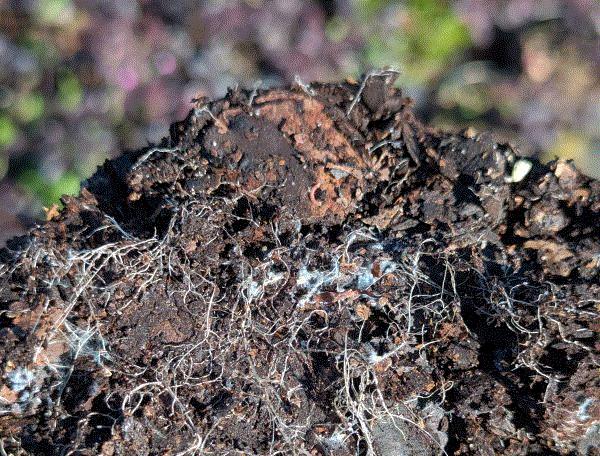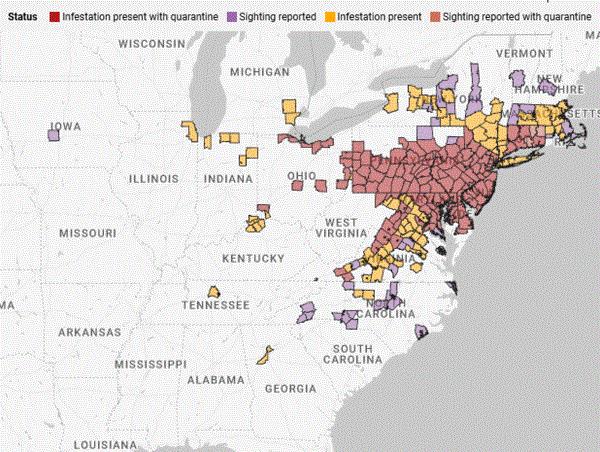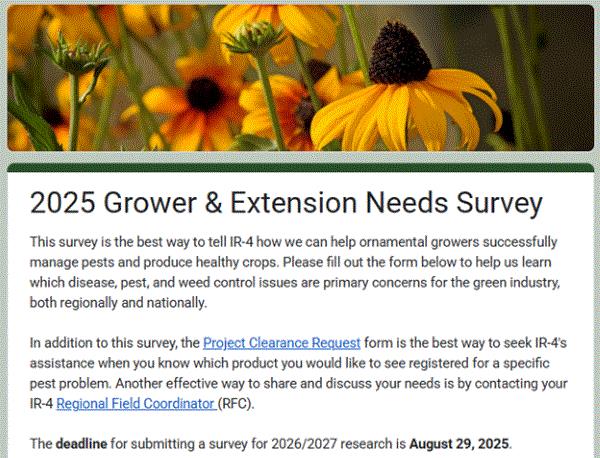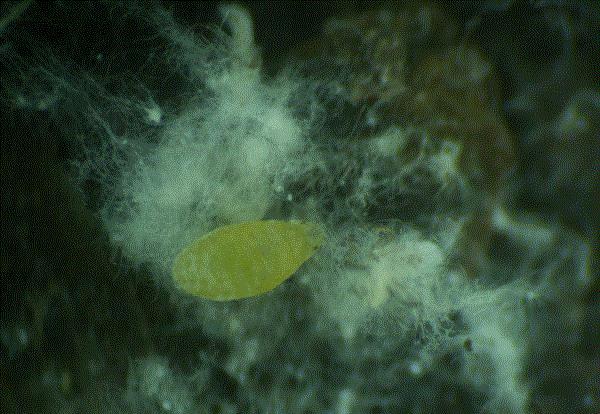What the ... ?
I received a series of pictures from a pest scout in Alabama last week showing what seems to be the classic fuzzy white patches of root mealybug infestations on the bottom of rootballs. You might think that the white fuzzes are on the roots of the crop—in this case, loropetalum. Oddly, the infestations appeared only on the roots of hairy bittercress. The scout wanted to confirm if these are root mealybugs and wondered if the creatures will spread to the loropetalum if the grower sprays out or hand-pulls the bittercress.

Smart and perceptive as y’all are, you probably can guess that these are no ordinary root mealybug infestations. So what are they? (Hint: Think about which plant family the bittercress belongs to. This creature is a specialist of this plant family this time of the year.) Does the grower have to worry about his loropetalum?
Spotted Lanternfly Has Been in Georgia Since …
… October 2024.
I was trying to tie up some loose ends from 2024 in the last issue, but quickly realized that I dropped other important news from 2024.
I knew as early as late October that spotted lanternfly was found in Georgia, but I didn’t want to talk about it until the detection has been authoritatively confirmed and made public. I waited and waited and ... well ... I forgot about it.
It was only when I was in the shower a few days ago that I thought, “Hey, what happened to the spotted lanternfly thing in Georgia?” You’d be surprised how many “I-wonder-if-I-had-done ...?” come to me in the shower.
So on November 14, 2024, the Georgia Department of Agriculture announced that spotted lanternfly infestations had been detected in Fulton County, Georgia (basically part of metro Atlanta), on October 22. The detection was officially confirmed by USDA-APHIS on November 14. Go HERE for the press release.

Current distribution of spotted lanternfly. (Source: New York State IPM Program.)
Fulton County joined the rank of Davidson County in Tennessee (around Nashville), Forsyth and Guilford County in North Carolina (around Winston-Salem and Greensboro) as the southern front of the spotted lanternfly invasion. No quarantine has been declared in Fulton County, but folks in the area are encouraged to report sightings via the online reporting tool.

IR-4 Pest & Disease Survey
The IR-4 Environmental Horticulture Program conducts its grower and extension survey every two years. The survey data are used to determine IR-4 research priorities for the next two years.
The biannual survey is once again upon us. Please consider participating in the survey by going HERE. The deadline for submitting your responses is August 29, but why wait?
Also, if you know a specific product you’d like to see registered to solve a specific problem, you can fill out a Project Clearance Request.

The survey starts by asking for your state, affiliation and business type. Name and other personal information are optional. Then the survey asks for the insects, diseases or weeds you had the most problems with last year, and what you do for pollinator and natural enemy protection. I completed the survey in less than five minutes.
Go HERE for the survey results from 2022/2023, which informed the priorities for the research conducted in 2024 and 2025. Based on the survey results, the national priorities for 2024 and 2025 were Phytophthora, Pythium, boxwood foliar diseases and crop safety for plant pathology; thrips, scale insects and crop safety for entomology; and crop safety for weed science. And there are multiple regional priorities. You can find out about them by going HERE.

Nominate a Young Grower or Young Retailer
Here’s a great opportunity to recognize great works done by young people in your operations: Nominate them for the Young Grower Award and Young Retailer Award! (Or you can nominate yourself or a peer.) Anybody under the age of 35 as of July 15, 2025, is eligible. Come on—don’t be shy!
This is the 21st iteration of the Young Grower Award and the 20th for the Young Retailer Award. The Young Grower Award is supported by GrowerTalks, Ball Horticultural Company and AmericanHort. The Young Retailer Award is supported by Green Profit, The Garden Center Group and AmericanHort. The prize sponsor is BASF.

Want to join the ranks of Drew Groezinger and McKenzie Lain on magazine covers? Nominate a peer or yourself for the Young Grower or Young Retailer Award.
Award finalists and winners will get a trip to and a fancy dinner at Cultivate, and gain fame (perhaps not great fortunate) by having their essays published in the June issue of GrowerTalks and Green Profit. Winners will be announced at the Unplugged event at Cultivate'25 and featured on the covers of the September issue of GrowerTalks and Green Profit.
Go HERE to submit a nomination for the Young Grower Award and go HERE for the Young Retailer Award nomination. Nomination deadline is March 1.

Answer to “What the … ?”
Like I said, y’all probably figured out by now that the white fuzzy patches on the bottom of these pots aren’t caused by root mealybugs. What’s infesting the roots of bittercress in this case is the cabbage root aphid.
Aphids? What?! Check out the close-up picture below. You don’t see the typical features of an aphid—there are no tailpipes (cornicles) and no long antennae. Look more like mealybugs.
Go HERE to read an article from Blake Layton of Mississippi State University, with a wonderful picture of a colony. There are nymphs of all sorts—wingless ones; ones with developing, dark-colored wing buds; and ones with tufts of white hairs projecting from their rear ends. There’s also an adult with wings.

The cabbage root aphid isn’t uncommon for those who grow brassicas each fall and spring. (I grow fall kales and collards because that’s just about the only vegetables I have success growing. I gave up on peas and lettuce a long time ago.) We can often see a huge infestation on the roots and below-ground stems when we pulled up the brassicas. Even though the infestation looks horrendous, it doesn’t seem to cause too many problems for the crop. This aphid species can feed on just about any cruciferous species, including bittercress.
I often forget that the cabbage root aphid has another common name—poplar petiolegall aphid because the summer generations cause swollen, empty galls on petioles of cottonwood (and other species of poplar). Many aphid species practice heteroecy, or a heteroecious life cycle, meaning that the summer generations use different hosts from the fall-spring generations. Often, the aphids have different reproductive behaviors on the two hosts. For the cabbage root aphid, the summer hosts are cottonwood and other poplar species, and the fall-spring hosts are brassicas. Blake’s article has a great description of the life cycle of cabbage root aphids.
Now, to the second question: Will they move on to and damage loropetalum once the bittercress is removed? The loropetalum is safe since the cabbage root aphid is a specialist of cruciferous plants and poplars.

What If It’s Root Mealybug?
Okay, the cabbage root aphid isn’t much of a concern unless, of course, your business is based on growing ornamental kales, alyssums, bittercress and other cruciferous plants. But what do you do if you come across an infestation of other root aphids or root mealybug species of concern?
I’d predicted this question two years ago, so I wrote about root aphid and root mealybug management in the April issue of this newsletter. What can I say? I may start a prognostication business. (I can’t see it, but I know my wife and her dog are shaking their heads vigorously behind my back.)
In the April issue of this newsletter, I introduced y’all to a paper by the late Stanton Gill of the University of Maryland and Brian Kunkel of the University of Delaware published in the December 2021 issue of the Journal of Environmental Horticulture. I hate to say it, but that paper is still the most recent study on rice root aphid and root mealybug management. Go HERE for a copy of the scientific paper. Go HERE for an article on root aphids and go HERE for a two-part series on root mealybugs, all of them by Stanton, Brian and their colleagues.
For root mealybugs, one application of Acelepryn (chlorantraniliprole; IRAC 28), Altus (flupyradifurone; 4D), Aria (flonicamid; 29) and Endeavor (pymetrozine; 9B) did well as curative treatments against existing infestations. (Okay, I double checked and I didn’t misspell flupyradifurone or call it some other trade name this time. My friends at Envu can rest easy tonight.)
Lots of other products also worked as curative treatments—three applications of Grandevo (Chromabacterium subtsugae; UNB), Mycotrol (Beauveria bassiana; UNF) and Venerate (heat-killed Burkholderia and fermentation medium; UNB); and one application of Mainspring (cyantraniliprole; 28) and Millenium (Steinernema carpocapsae; UC).
For rice root aphid, the most effective curative treatments were Acelepryn, Mainspring and Endeavor. No preventive treatment was evaluated in this study. Can these products be used against cabbage root aphid? I think so, but why do you want to do that if you aren’t growing cruciferous crops?
It may seem silly for me to make this note because it seems obvious, but I should anyway: Treatments against root aphids and root mealybugs should be made as a drench or sprench because these creatures feed on the roots underground. Also, there are other products whose efficacy against root aphids and root mealybugs should be explored. No one does that study right now, as far as I know. I hope someone will pick up the baton and run to find more solutions for these pests.



See y'all later!

JC Chong
Technical Development Manager at SePRO
Adjunct Professor at Clemson University
This e-mail received by 27,847 subscribers like you!
If you're interested in advertising on PestTalks contact Kim Brown ASAP!